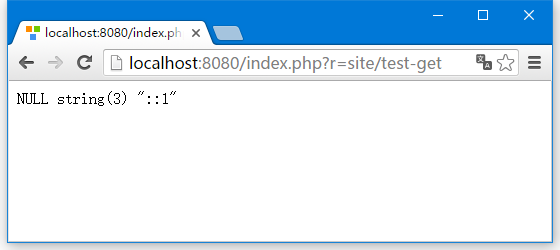Requests是 yii\web\Request 对象的表示,它提供了HTTP头,请求参数,Cookies等信息。
get() 和 post()方法返回请求组件的请求参数。
示例 −
$req = Yii::$app->request;
/*
* $get = $_GET;
*/
$get = $req->get();
/*
* if(isset($_GET['id'])) {
* $id = $_GET['id'];
* } else {
* $id = null;
* }
*/
$id = $req->get('id');
/*
* if(isset($_GET['id'])) {
* $id = $_GET['id'];
* } else {
* $id = 1;
* }
*/
$id = $req->get('id', 1);
/*
* $post = $_POST;
*/
$post = $req->post();
/*
* if(isset($_POST['name'])) {
* $name = $_POST['name'];
* } else {
* $name = null;
* }
*/
$name = $req->post('name');
/*
* if(isset($_POST['name'])) {
* $name = $_POST['name'];
* } else {
* $name = '';
* }
*/
$name = $req->post('name', '');
第1步 - 添加一个 actionTestGet 函数到基本应用程序模板的控制器 SiteController 中。
public function actionTestGet() {
var_dump(Yii::$app->request->get());
}
第2步 - 现在打开URL=> http://localhost:8080/index.php?r=site/test-get&id=1&name=zaixian&message=welcome ,
你会看到以下内容。
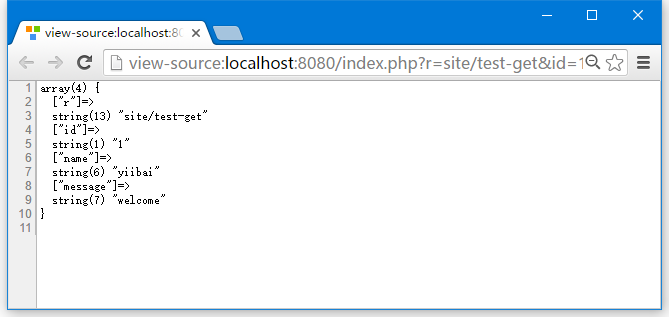
要检索的另一个请求方法的参数 (PATCH, DELETE, etc.), 使用 yii\web\Request::getBodyParam() 方法。
要获得当前请求的HTTP方法,使用Yii::$app→request→method 属性.
第3步 - 修改 actionTestGet 函数,如下面的代码。
public function actionTestGet() {
$req = Yii::$app->request;
if ($req->isAjax) {
echo "the request is AJAX";
}
if ($req->isGet) {
echo "the request is GET";
}
if ($req->isPost) {
echo "the request is POST";
}
if ($req->isPut) {
echo "the request is PUT";
}
}
第4步 - 转到 http://localhost:8080/index.php?r=site/test-get .
你会看到结果如下所示:
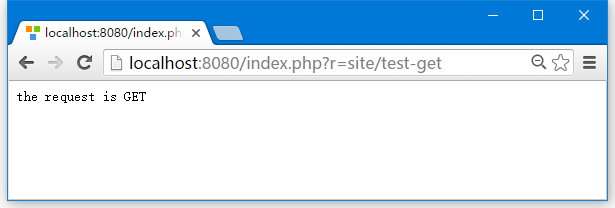
所请求的组件提供了很多属性来检查请求的URL。
第5步 - 修改 actionTestGet 函数如下。
public function actionTestGet() {
//the URL without the host
var_dump(Yii::$app->request->url);
//the whole URL including the host path
var_dump(Yii::$app->request->absoluteUrl);
//the host of the URL
var_dump(Yii::$app->request->hostInfo);
//the part after the entry script and before the question mark
var_dump(Yii::$app->request->pathInfo);
//the part after the question mark
var_dump(Yii::$app->request->queryString);
//the part after the host and before the entry script
var_dump(Yii::$app->request->baseUrl);
//the URL without path info and query string
var_dump(Yii::$app->request->scriptUrl);
//the host name in the URL
var_dump(Yii::$app->request->serverName);
//the port used by the web server
var_dump(Yii::$app->request->serverPort);
}
第6步-在Web浏览器地址栏中输入URL=>http://localhost:8080/index.php?r=site/testget&id=1&name=zaixian&message=welcome,
你会看到以下内容。
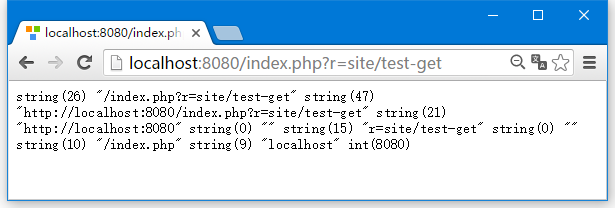
第7步 - 要获得HTTP头信息, 需要使用 yii\web\Request::$headers 属性. 修改 actionTestGet 这样的动作。
public function actionTestGet() {
var_dump(Yii::$app->request->headers);
}
第8步-如果你打开网址URL=>http://localhost:8080/index.php?r=site/testget&id=1&name=zaixian&message=welcome,
你会看到如图所示的代码输出。
要获得主机名和客户机的IP地址,使用 userHost 和userIP 属性。
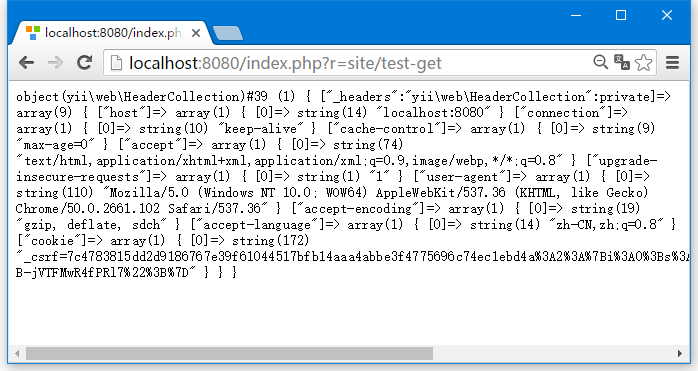
第9步 - 需要像这样修改 actionTestGet 函数。
public function actionTestGet() {
var_dump(Yii::$app->request->userHost);
var_dump(Yii::$app->request->userIP);
}

